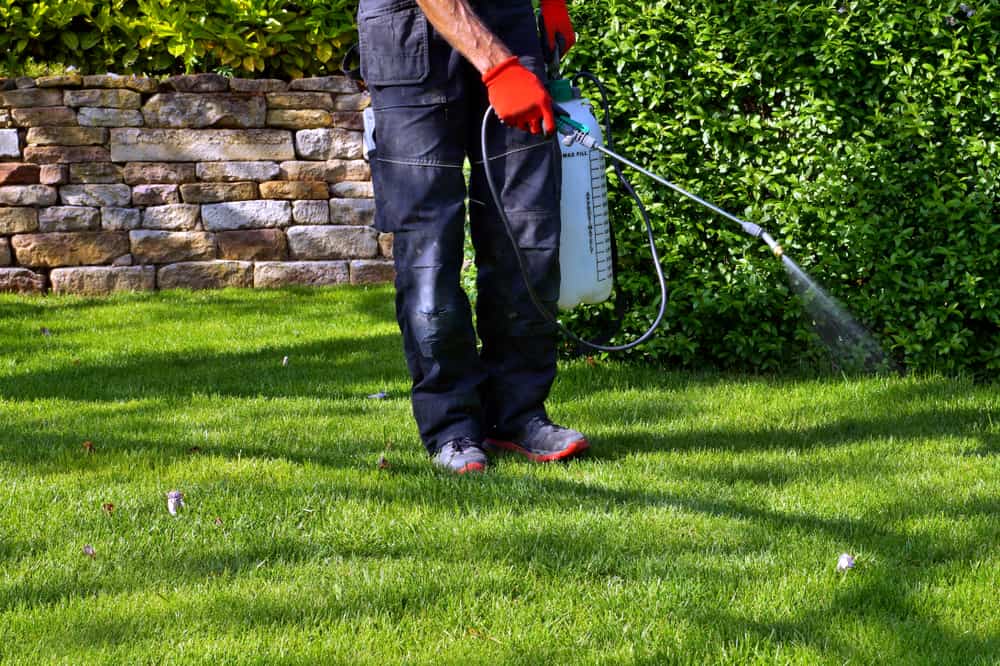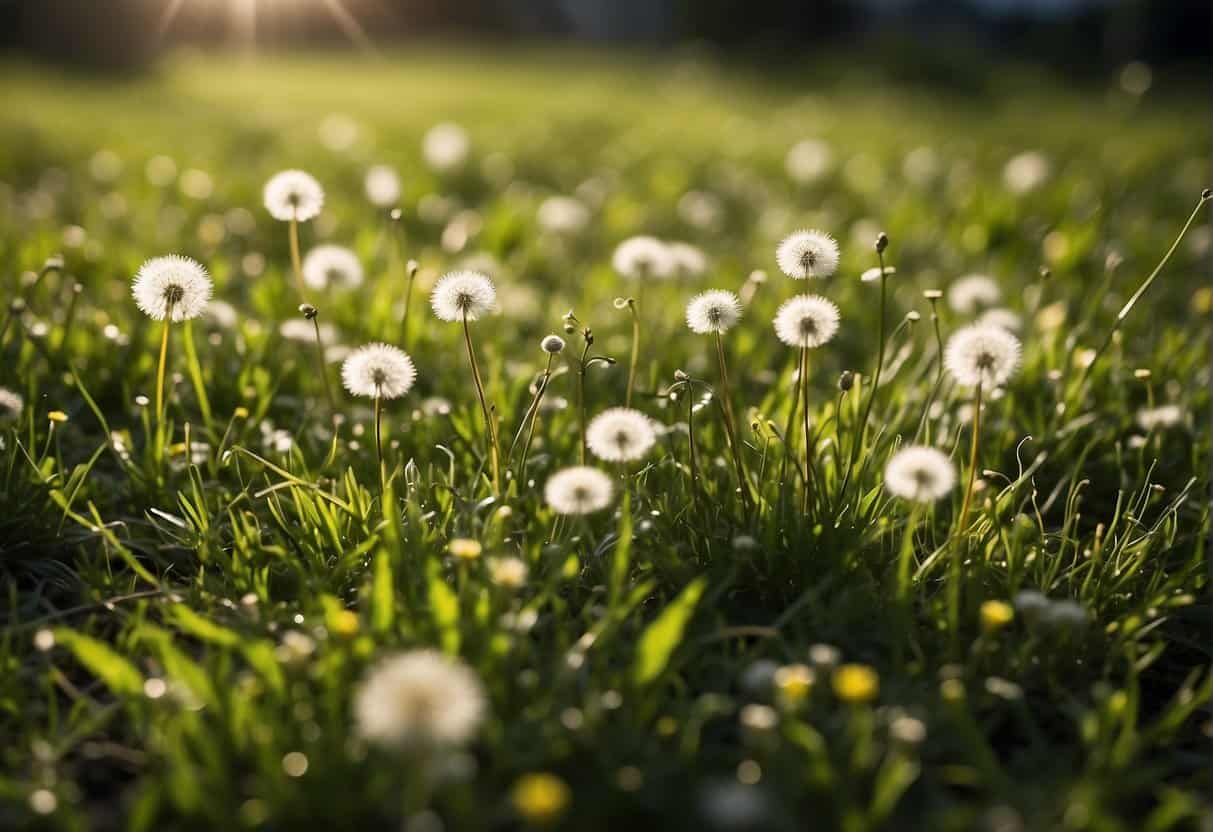Battling a lawn overrun with weeds? With the right tactics, transforming your wild meadow back into a lush, green haven is within reach. Start by identifying the weed types and choosing the right method of attack, be it selective herbicides or manual removal. Revive your lawn with a mix of proper feeding, watering, and maintenance.
Get set to turn your weedy yard into an enviable outdoor sanctuary, perfect for family gatherings and leisure, and learn how consistent care can keep those pesky weeds at bay permanently
Understanding Weeds in Your Lawn
Weeds can be quite the headache in your garden, but getting to know them is the first step in reclaiming your lawn. There are generally two groups of weeds you’ll encounter:
1. Grassy Weeds: This group includes weeds like crabgrass and are tricky because they mimic your lawn grass in appearance. Challenges in managing grassy weeds arise from their similar growth patterns and structure.
2. Broadleaf Weeds: These weeds are usually easier to identify and target because they have larger leaves, which often look quite different from your lawn grass. Examples include dandelions and clover.
Weeds compete for space, light, water, and nutrients, often growing more vigorously than the surrounding grass.
Additionally, timing is key for weed management. Applying treatments in the correct season can prevent or reduce the spread of weeds, with spring and summer being critical times for many common weeds. This is when many weeds are actively growing, making them more susceptible to treatment.
Identifying Common Lawn Weeds
When you’re facing a lawn full of weeds, the first step to reclaiming your green space is figuring out what you’re up against. In Australia, you’ll likely encounter a variety of common weeds that can become quite a nuisance.
Due to such a large diversity in climates, you will likely be able to narrow down the types of weeds you have in your yard based on what region you live in.
Here is a guide for identifying 13 common weeds that are likely to grow in your lawn. With this knowledge, you will be well underway to rid your yard of whatever weeds are trying to take over.
The Importance of Lawn Health
A healthy lawn plays a crucial role in weed management for several reasons:
- Competition for Resources: A dense, robust lawn competes effectively for sunlight, water, and nutrients, leaving fewer resources available for weeds. When the grass is thick and healthy, it’s more difficult for weeds to establish and spread.
- Shade and Coverage: Healthy grass blades provide significant ground coverage and shade the soil, hindering weed seed germination. Many weed seeds require direct sunlight to germinate, so a thick lawn can effectively block this light.
- Reduced Soil Exposure: A well-maintained lawn minimizes bare spots and soil exposure. Weeds often take hold in bare patches where the grass is weak or absent, so having a full, healthy lawn reduces these opportunities.
- Disease and Pest Resistance: Healthy lawns are better equipped to resist diseases and pest infestations that can weaken grass and create openings for weeds.
- Promotes Beneficial Microorganisms: Healthy soil with a well-maintained lawn supports a diverse ecosystem of microorganisms that can outcompete or inhibit weed growth.
- Physical Barrier: The root system of a healthy lawn creates a dense network that acts as a physical barrier, making it harder for weed roots to penetrate and establish.
- Aesthetic and Functional Appeal: Beyond weed management, a healthy lawn contributes to the overall aesthetic appeal of a landscape, improves air quality, and offers a pleasant and functional space for outdoor activities.
Maintaining a healthy lawn is a proactive and natural way to manage weeds. It reduces the need for chemical interventions, making it an environmentally friendly and sustainable approach to weed control.
Organic Weed Control Methods
In your quest for a healthy lawn without the use of harsh chemicals, consider these organic methods that can effectively reduce and manage weeds.
Hand Weeding
Grab a pair of gloves and get down to the roots of the problem quite literally. Here are some tips to help you get rid of the weeds in your lawn once and for all:
- Choose the Right Time: It’s easier to hand weed when the soil is moist, such as after a rain or watering. The weeds will come out more easily, roots and all.
- Identify the Weeds: Know what kind of weeds you’re dealing with. Some have deep taproots (like dandelions), while others have spreading root systems.
- Use Proper Tools: While many weeds can be pulled out by hand, tools like a dandelion digger, weeding fork, or garden knife can help with stubborn roots. Wear gloves to protect your hands.
- Technique for Pulling Weeds: Grasp the weed as close to the base as possible and pull gently but firmly, trying to get as much of the root as possible. For deep-rooted weeds, wiggle the tool back and forth to loosen the soil around the root before pulling.
- Dispose of Weeds Properly: Place the removed weeds in a yard waste bin or compost them if they haven’t gone to seed. Avoid composting weeds with seed heads, as they might sprout again.
- Fill in Bare Spots: After removing weeds, fill in any bare spots with grass seed to prevent new weeds from taking hold.
Remember that consistent hand weeding may be necessary to keep your lawn clear.
Natural Herbicides
You can create your herbicides from everyday household products. A mixture of vinegar and water can serve as a natural herbicide, as well as a solution of diluted rubbing alcohol and water.
These should be applied directly to the leaves of the weeds to avoid harming your grass or other plants.
Chemical Weed Killers
When you’re aiming to save your lawn from weeds, chemical weed killers can offer an effective solution. These are powerful tools in your arsenal, but it’s crucial to select the right type for your specific weed problem.
Selective Herbicides
Selective herbicides target specific types of weeds without harming your lawn. These products are excellent if you’re dealing with broadleaf weeds such as dandelions or clovers in a lawn of desirable grasses such as buffalo or Kikuyu.
Make sure to read the label carefully, as some herbicides are designed for particular grass types, and using the wrong one could damage your turf.
Non-selective Herbicides
On the other side, non-selective herbicides will kill nearly any plant they come into contact with. This type is handy when you need to clear out a large area for replanting.
Given their potency, use these herbicides with extra caution – they can kill your grass, and garden plants, and even harm nearby waterways if not used responsibly.
Integrated Weed Management
When you’re faced with a lawn full of weeds, it can be quite a challenge. Integrated Weed Management (IWM) is a comprehensive approach that can help you tackle the problem efficiently.
It blends cultural, mechanical, and chemical methods, aiming not only to fight weeds but also to prevent their return.
Cultural Control
This involves adjusting your lawn care practices to give the desired grass the upper hand over weeds. This might mean improving soil health, changing your mowing habits, or using competitive plant species that discourage weed growth.
Some turf types, like Buffalo grass, are more resistant to weeds due to their dense growth. By focusing on creating an unfavourable environment for weeds, you are proactively reducing their chances to thrive.
Mechanical Control
Sometimes, getting down to the nitty-gritty is necessary. This can involve physically removing weeds, either by hand or with tools. Regular mowing at the correct height is also a mechanical control method, as it can help the grass to outcompete weeds.
Chemical Control
Using herbicides should be a last resort, but when it’s necessary, choose selectively and use them judiciously. It is key to follow label instructions to avoid harming your lawn or the environment.
Weeds Australia suggests integrating these techniques to enhance the chances of success and minimise risks such as herbicide resistance.
Remember, the goal of IWM is not just to remove weeds but to maintain a healthy lawn that is less susceptible to weed invasion. It’s about taking a planned and informed approach to weed management that considers the long-term health of your lawn.
Renovating a Weed-Infested Lawn
If your lawn has been overtaken by weeds, renovation may be required to restore its health and appearance. Here’s how you can tackle a weed-infested lawn:
1. Identify Weeds
Start by identifying the types of weeds in your lawn. Broadleaf weeds like dandelions are different from grassy weeds such as crabgrass. Each type might require a different approach.
2. Mowing
Mow your lawn to a shorter height to stress the weeds; however, never remove more than a third of the grass blade at one time to avoid damaging the lawn.
3. Weed Removal
For small areas, hand weeding can be effective. Large infestations might require a selective herbicide that targets weeds while sparing your grass.
4. Aeration
A compacted lawn can favour weed growth. Aerate your lawn to improve soil compaction and allow air, water, and nutrients to reach the grass roots.
5. Reseeding
Choose a grass seed suitable for your climate and lawn conditions. Overseed the existing lawn to create a dense turf that can outcompete weeds.
6. Fertilisation
Apply a slow-release fertiliser to provide nutrients over time, which supports grass growth over weeds.
7. Regular Maintenance
Adopt a consistent lawn care schedule, including proper watering and mowing, to maintain your renovated lawn and prevent future weed problems.
By following these steps, you can transform your weedy lawn into a lush and healthy green space.





